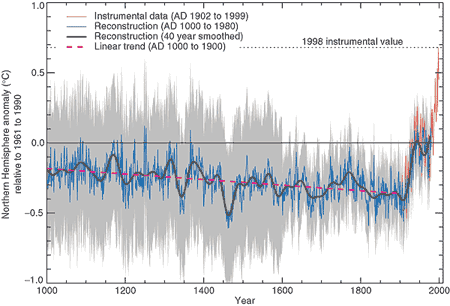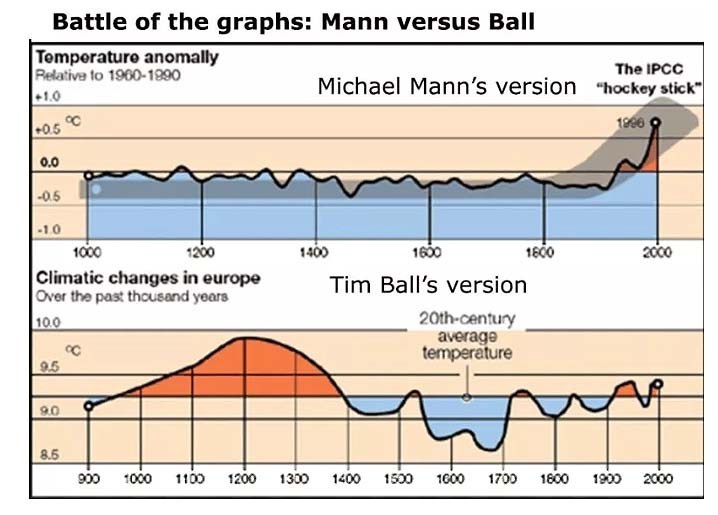Michael Mann is a Penn State professor who is famous for having generated the “hockey stick” graph that was published as part of a 2001 report of the United Nations Intergovernmental Panel on Climate Change (IPCC). The data used in the graph is largely based upon measuring tree-ring thicknesses in bristle cone pine trees, and then concatenating actual temperature measurements onto the historical data that he inferred from the tree rings. Mann’s graph wiped out a well established period of warmer weather called the “medieval warm period,” and shows drastic warming in recent years, presumably due to carbon dioxide that is a by-product of the burning of fossil fuels:
The Infamous “hockey stick” graph
The science behind the graph has been hotly contested for decades now, with many scientists saying that Mann was playing games with the data. Two Canadians, Steven McIntyre and Ross McKitrick, examined Mann’s study in 2003 and stated that Mann’s computer model would generate a hockey stick regardless what data were fed into it. They also stated that the small sample of Bristlecone Pines in the Western U.S. that Mann had used was not representative (a later study by an English university used a single Siberian tree).
But Mann has been aggressive about suing his critics to cause expense and inconvenience and to dissuade others from coming forward with public criticism. He has been involved in a seven year lawsuit with Mark Steyn and National Review over a very short blog post that Steyn posted at NR’s online site.
He also sued Dr. Tim Ball in Canada. Ball had stated that Mann, “belongs in the state pen, not Penn State.” In other words, Dr. Ball openly accused Mann of deliberate fraud in creating the “hockey stick” graph. The lawsuit, filed in 2011, lasted until last Friday afternoon, when the Canadian court finally, after eight (8) long and expensive years of litigation, finally threw it out.
Ball’s defense was simply: I told the truth; I can prove Mann is a fraudster if he will show me his supporting math. Ball demanded to see Mann’s homework, specifically his R2 regression analysis. Mann refused to produce it, claiming it was “proprietary information,” i.e., intellectual property worth money to him. The court sided with Ball, ordering Mann to turn over his regression analysis by February 2017, which, you will note, is two and half years ago. And yet Mann refused to “show his work.” He refused to produce his regression analysis, despite having been ordered to do so and given plenty of time to comply.
At last, the judge ran out of patience with Mann, threw out the case, and ordered Mann to pay costs, which in Canada, unlike America, includes attorneys’ fees. Mann is threatening to appeal, but I cannot imagine any appellate court being sympathetic to a plaintiff who refused to turn over obviously relevant discovery, and even flouted a direct court order to do so.
Real science requires open access to data, so that skeptical scientists can see if the initial results are reproducible. When scientists hide their data, they aren’t doing science, they’re doing something else. In this case, that “something else” looks a lot like propaganda.



